| |
[exhibition
space] ----------------------------------------------

The
first version of this project was shown at: TRACER SIX
CURATORS ON ART IN ROTTERDAM TENT.
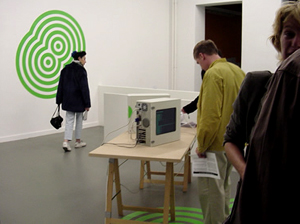
gepubliceerd op: 30.08.2004 Neuralgic,
an exhibition project for TRACER by Andreas Broeckmann and Stefan
Riekeles, Rotterdam/Berlin, Summer 2004
Zaaloverzicht Knowbotic Research naked bandit / here, not here / white
sovereign 2004
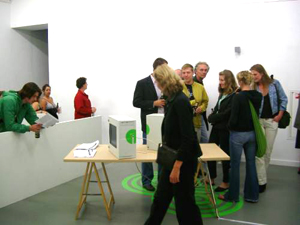
 |
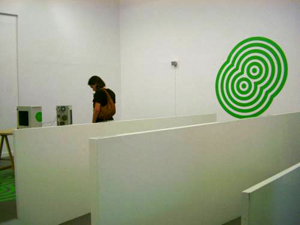 Witte
de With September 10 – October 24, 2004
Witte
de With September 10 – October 24, 2004
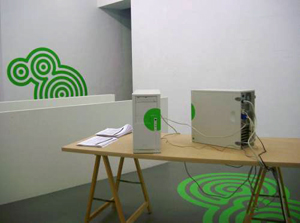
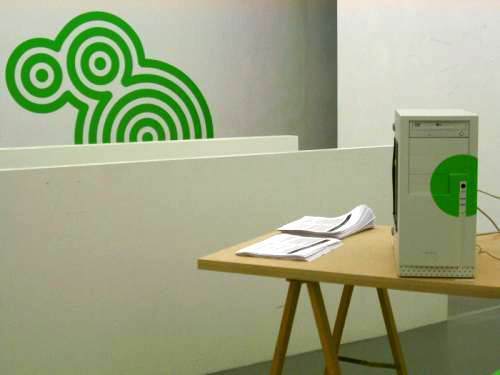
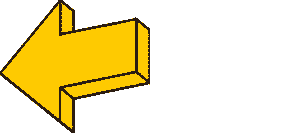
|
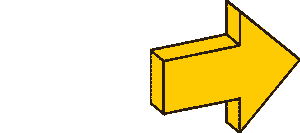
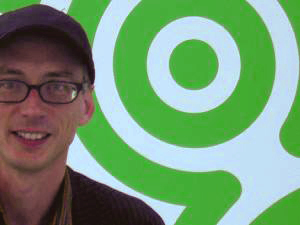
The project by the artists group by Knowbotic Research (KRcF), currently
working in Zurich and Cologne, forms part of a series of works that
engage with the experience of total inclusion, and with hypothetical
scenarios for becoming able to act in a situation where independent
action is systematically denied. Naked Bandit / here,not here / white
sovereign is based on a technical scenario, represented through a
software process, in which one 'parent' process controls another,
the 'child' process. In analogy to Giorgio Agamben's analysis of the
homo sacer, the 'nude bandit' is a figure caught up in a dependent
relationship in which it has to report its continued presence ('here'),
yet, is prevented from acting or leaving ('not here'). By offering
an interface for a basic intervention into this scenario, the exhibition
visitors are confronted with their implication into situations where
the modern state systematically prevents people on the margins of
society, from engaging their human and citizen rights.
Andreas Broeckmann

|

Andreas Broeckmann / Stefan Riekeles (DE) (b. 1964)
lives and works in Berlin. Since fall 2000, he has been artistic director
of the transmediale International Media Art Festival in Berlin. Broeckmann
studied the history of art, sociology and media science. From 1995
through 2000 he worked as a project leader and curator for the V2_Organisation,
Institute for the Unstable Media, in Rotterdam. He is a member of
the mikro Verein zur Pflege von Medienkulturen e.V. in Berlin and
co-founder and coordinator of the European Cultural Backbone, a network
of European media culture centers. He has recently published articles
in Next 5 Minutes 4 Reader (Amsterdam, 2003) and Medien/Kunst/Praxis.
Eine Festschrift für Micky Kwella (Berlin, 2004-). Kunstenaars/ artists:
AGF aka antye greie, Ursula Biemann, Joe Cillen, Joost Conijn, Dick
el Demasiado, Heidrun Holzfeind, Knowbotic Research, Marnix de Nijs
|
Neuralgic
an exhibition project for TRACER by Andreas Broeckmann
and Stefan Riekeles, Rotterdam/Berlin, Summer 2004
Contemporary Neuralgia
Our time is riddled by the pressing urgency of a change which is imminent,
yet, for which we have no guidelines and few utopian visions.
We experience the pains, the cynicisms and the helplessness of
a globalised world, fully aware of its unsustainability.
The exhibition project Neuralgic raises the question of how to react
to the need for change. Taking oil and the technical 'nervous
system' as its central metaphors and examples, Neuralgic
investigates the vital infrastructure of contemporary societies,
and how this infrastructure affects the way in which we
live, and how we can translate our experiences into forms
of expression and action.
Eight European artists have been invited to explore such 'neuralgic
areas' and their imaginary potentials.
Emergency
Plans: 90 days to shake the world
|
The
harbour of Rotterdam holds one of the largest oil reserves in Europe.
It plays a key part in the emergency plans of the International
Energy Agency (IEA) whose member states have committed to
keep a reserve of ninety days worth of oil imports, for the event
of an international crisis. This stock can be used in order
to control the oil price on global markets (as happened
recently, during the Iraq war in 2003), or as a final reserve
in the case of war, or other serious crises. In this scenario,
the 90-day period during which some emergency plan would
kick into action, can be taken as a symbol for the kind
of radical change which is potentially imminent, undesirable
yet expected, and which would have to replace our society's
dependency on oil by some other model of sustenance.
Rotterdam
and the infrastructure around it would, no doubt, play an important
role in the ensuing scenario, given its strategic position and
content. Yet, it might be argued that the city of Rotterdam proper
would actually have no role in this, and that it is only the harbour
which has such a neuralgic position for Europe's energy supplies.
Thus, the city of Rotterdam, as it is experienced by its inhabitants,
would be but a marginality in relation to the waterway, motorway,
rail and information technologies infrastructure that constitutes
the harbour.

|
However,
the project Neuralgic does not seek to indulge in apocalyptic
horror scenarios. Rather, we want to take the neuralgic position
of Rotterdam as a metaphor for the need to radically rethink the
way in which we live. The oil in the harbour of Rotterdam and the
90-day potential it holds, is a strong, resonating image
for the conflicts and potentials for change that we are
challenged to imagine.
Neuralgia is "a disease, the chief symptom of which is a very
acute pain, exacerbating or intermitting, which follows
the course of a nervous branch, extends to its ramifications,
and seems therefore to be seated in the nerve." (Webster's
Revised Unabridged Dictionary, 1998) Neuralgic pain extends
through the filiations of the nervous system. It seems
to be difficult to locate and independent of any structural
lesion, and in many cases there is no identifiable cause for
it. By analogy, we use the term 'Neuralgic' as a metaphor for contemporary
problems with cannot easily be pinned down and localised,
but which evolve in relations, along trajectories, through distributive
systems. These are not 'unidentifiable', UFO-style problems,
but one's which need to be traced and tackled in the complex
relational and conditional topologies of our contemporary world.
 |
Neuralgic
looks at the geo-political, social and technical infrastructure,
at contemporary modes of living and surviving, and at the
possibilities for action and change. The project departs from the
belief that art holds a potential to imagine such a scenario
not as one of catastrophy and apocalypse, but as one of
optimism, humour, absurdity, or sadness, as a way of dramatising
the imaginable beyond the supposedly realistic, and without
forgetting that there is a pressing reality that urges
us to ask this hypothetical question.
Reformulations: Eight Projects
The artists who were invited to contribute projects to
the Neuralgic exhibition took the conceptual framework
not as a scenario for illustration, but as a point of departure
and a sounding board for their on-going work.
The Motorschip Noordereiland is a Rotterdam-based project that has
been running for over a decade and that offered a response
to the Neuralgic question long before the latter was formulated.
The MS Noordereiland is a ship, anchored in the river Maas
right in the center of Rotterdam. Many mistake it for an
island, but in fact the crew of the MS Noordereiland has
taken great pains over the last years to prepare for the
imminent departure of the ship. Like every person on board,
and like the world itself, the MS Noordereiland is a vessel
and a vehicle of our imagination, that makes it possible to project
ourselves into ever new, ever different, ever more acceptable conditions.

|
Caspian
Crude by the Swiss artist Ursula Biemann is part of a long-term
investigation of the Black Sea and Caspian Sea oil industries
and how they connect with the Western European economies and
societies. On her journeys through Turkey, Armenia and Azerbaijan,
all the way to the oil fields off Baku, Biemann traces the
construction of the oil pipelines that are both physical evidence
and metaphor for the way in which East and West are connected
and interdependent in the survival game of exploiting the
fossil resources of the Earth. Biemann's observations of
people's lives along the pipeline, of workers, farmers
and nomads, give a human face to the infrastructural project
that is intended to feed the raffineries and oil tanks
in Rotterdam's harbour for years to come.
As a strictly alternative project to this infrastructural
enterprise, Joost Conijn's Wood Car realises the vision
of being independent from fossil fuels: Conijn has constructed
a car that is made of wood, and whose motor runs on wood.
Wherever he meets people along the way, they marvel at
his wonderous contraption. It is hardly surprising that
the journey which Conijn's video documents takes him in the direction
opposite to that of the oil flowing through the pipelines from
Baku to Rotterdam: he travels through the Black Sea countries of South-East
Europe, and in the Romanian countryside he finds people for
whom his car is as hopelessly obsolete and quaintly utopian - as it
is for his Dutch viewers.
 |
Marnix
de Nijs, based in Rotterdam, introduces an Oil Reserve into the
space of TENT. which stores an amount of oil that has been claimed
for cultural and artistic activities in the case of a crisis as
outlined in the 90-days scenario. This concrete reserve addresses
the need for a protection of resources that is not guided
by commercial interests or political goals, and positions
a neuralgic spot right in heart of an art institution.
The politics of oil supply and consumption are poised in
a relation of offence and defense, a relation that the
installation translates into a dramatic threat: on the
occasion of an illegitimate abuse of its purpose, it will violently
self-destruct.
EXPOSED, a work in progress by Austrian artist Heidrun Holzfeind,
based in New York, is a film about a young woman who suffers
from Multiple Chemical Sensitivity. This chronic condition
caused by exposure to chemicals found in common products
is a by-product of our modern, technologically advanced
world. While critics still question its validity, for Katherine,
the main character in the film, it is a debilitating everyday
reality forcing her to live outside of the norms of society.
As Katherine puts it: "Chemical Intolerance has changed
my life - mostly spiritually, and also the way that I think about
society and status quo mentality...?
 |
agf
is an artist and musician based in Berlin who, over the last years,
has developed an artistic language, mainly through electronic music,
in which she combines a highly personal poetics with a strong engagement
with social and political issues concerning the world around
her. Her project seeks to identify neuralgic dimensions of contemporary
society which she formulates in calligraphic paintings as
well as in short sound pieces. It is a special quality of agf's work
that she conveys critical issues as emotionally charged and immediately
touching aesthetic experiences - bringing us very close to
where the general neuralgia can be felt as our own pain.
The project by the artists group Knowbotic Research (KRcF), currently
working in Zurich and Cologne, forms part of a series of
works that engage with the experience of total inclusion,
and with hypothetical scenarios for becoming able to act
in a situation where independent action is systematically
denied. Nude Bandit: Here,Not Here is based on a technical
scenario, represented through a software process, in which
one 'parent' process controls another, the 'child' process. In analogy
to Giorgio Agamben's analysis of the homo sacer, the 'nude bandit'
is a figure caught up in a dependent relationship in which it has
to report its continued presence ('here'), yet, is prevented from
acting or leaving ('not here'). By offering an interface
for a basic intervention into this scenario, the exhibition
visitors are confronted with their implication into situations
where the modern state systematically prevents people on
the margins of society, from engaging their human and citizen
rights.
 |
Dick
el Demasiado returns us to the initial scenario of the Neuralgic project
and imagines the situation when the crisis kicks in: Hoe vertel
ik het het volk? (How do I tell the people?) The prolific artist
has recently developed a career as the instigator of 'Cumbias Lunaticas',
a special sort of distorted Latin American popular music, which
has become highly popular with people in Argentina and other countries.
The Latin-American post-colonialist experience, as well as the
current economic and social crisis in Argentina, are an important
subtext to his work. - The announcement on the ATM money
machine: 'Het is op!' ('The money's up!'), supported by
one of his songs screeching from the small sound monitor,
turns the tables on the normal experience of crisis in
globalisation: It exhibits the moment of drawing money
'from the wall' - that exemplary instance of Western affluence
and security -, as the moment when the global drama will 'hit
home'. Without doubt, in the vision of the Non-Western artist, that
event will hold some deeply ironic beauty.
Placebo
Art can, of course, not heal neuralgic pains. It can, at best, point
out the cultural filiations through which they ramify,
and propose hypothetical strategies for running through,
maybe even bending them. Neuralgic deals with some aspects
of the contemporary geo-political and social infrastructure,
with exemplary survival strategies and with modes of agency.
There is a complex interdependency between infrastructure,
life, and action, all of which mutually condition each
other. Such conditional relations have to be looked at precisely and
individually, in order to be able to use them effectively and determine
whether the intended expressions and actions can unfold in the
main branches of the infrastructure, or whether they have to be couched
in niches or an imaginary outside. A recurring experience is that
of the reliable instability of living and technical systems, an experience
of temporary failures and permanent flaws.
 |
 |


